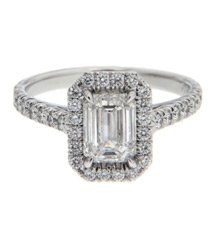Marquise cut, pronounced as ‘mar-keys cut’, are also known as ‘Navette’ (“little bloat”) cut diamonds, due to their resemblance to a boat’s hull. Because of its large crown surface, a marquise cut can appear to be larger than its actual carat weight. Its elongated shape can make a marquise cut diamond ring look very elegant, and the finger its upon seem slimmer and longer. The symmetry of this fancy shape is very important, requiring that the two pointed ends be aligned and that the sides of the stone form a near mirror image.
Before purchasing this cut, make sure that the pavilions are not too deep or improperly proportioned, which may display a gray to black bow tie. Bow ties are visible across the width of the stone when viewed face up.
 Fancy cut diamonds have been around for longer than the gold standard, the round brilliant cut. Some fancy cuts are born out of a desire to preserve carat weight while still shining, and others are whimsical shapes meant to delight connoisseurs. One cut, the marquise, came about as a special request.
Fancy cut diamonds have been around for longer than the gold standard, the round brilliant cut. Some fancy cuts are born out of a desire to preserve carat weight while still shining, and others are whimsical shapes meant to delight connoisseurs. One cut, the marquise, came about as a special request.
Marquise cut diamonds are said to have originated in France, at the request of King Louis XV. He was deeply in love with a beautiful and witty woman named Jeanne Antoinette Poisson. When she joined the nobility in 1745 as the Marquise de Pompadour, Louis XV wanted a gift that best reflected how much he adored her. The result was the marquise cut diamond, shaped to resemble the outline of her lips.
Marquise cut diamonds are a fancy brilliant cut which resembles an oval with pointed ends. Ideal marquise diamonds are symmetrical, their two points aligned with one another. The diamonds’ length makes them look larger than their carat size, but shouldn’t be too narrow. Optimal length to width ratios are between 1.75:1 and 2.25:1. There is no standard faceting style, though their pavilions have gotten narrower since 1919 and the influence of the round brilliant cut diamond.
For diamond lovers seeking a romantic yet subtle diamond, marquise cuts are an excellent option. Wearing one will make you feel as elegant as a French courtier, and as sophisticated as its namesake. Its uncommon shape will charm anyone who sees it.
The Brilliance and Exclusivity of Marquise Cut Diamond
Unlike the more traditional choice of a round brilliant or princess cut diamond, marquise cut diamonds are definitely less common choice among buyers. Because of their narrow and long shape, a marquise creates an illusion of greater size. Among all diamond shapes, the marquise diamond has one of the biggest crown surface areas, making it an excellent choice when seeking to maximize the perceived size of the stone.
A modified brilliant cut, the uniquely football-shaped marquise diamond maximizes carat weight and offers comparatively a larger-looking diamond much to the delight of the customer. The elongated shape of the marquise cut diamond makes fingers appear slender and longer.
Marquise Cut Diamond: Things to Know
Marquise diamond possesses some extent of bow-tie effect, ranging from severe to near invisible. Unless you visually inspect the actual diamond, the visibility of bow-tie cannot be effectively ascertained simply by evaluating the diamond certificate.
Finding the perfect dimensions in a marquise, look for its precise length to width ratio. The length to width ratio determines the outline of the diamond or its appearance when viewed from the top. Personal preferences should decide how fat or narrow a diamond you opt for. However, a length to width ratio between 1.75 and 2.15 or 2.25 is considered the classic and ideal marquise cut.
Symmetry also plays a vital role in marquise cuts. The twin end points should align perfectly with each other, and the left and right sections must form virtually a mirror image. Even an insignificant misalignment in the two points can lead to an off kilter appearance in the final setting. Hence, Very Good or Excellent symmetry is highly recommended.
A marquise cut diamond at all time should be set with prongs to safeguard the two points which are the most likely locations for chipping. Also, these points also tend to have a density of flaws like extra facets, other inclusions, and naturals. Since the points get covered by prongs, these imperfections will remain unseen once the stone is set.
Color preferences in a marquise cut diamond, is again, subjective. As compared to different diamond shapes, in larger – more than 1 carat – marquise cut diamonds, the color may appear mildly darker at the points. For this reason, customers may decide to move up one color grade.
A marquise diamond with its exclusive shape it is an ideal choice for a diamond aficionado.





